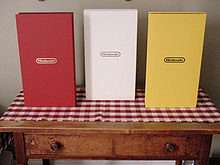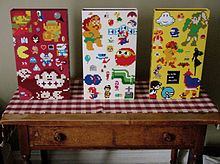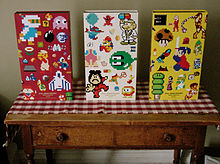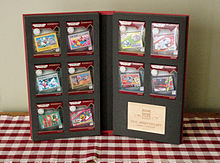- Classic NES Series
-
Classic NES Series Developer(s) Various Publisher(s) Nintendo Distributor(s) Nintendo Designer(s) Various Series Classic NES Series Platform(s) Game Boy Advance Release date(s) 2004-2005 (various) Genre(s) Various Mode(s) Various Rating(s) ESRB: E (Everyone)
CERO: A (All ages)
PEGI: 3+
OFLC: GMedia/distribution cartridges The Classic NES Series in North America (Famicom Mini Series in Japan and NES Classics in Australia and Europe) are a series of Game Boy Advance games that were originally released on the Nintendo Entertainment System (the Family Computer and the Disk System in Japan) emulated on the Game Boy Advance. A special edition Game Boy Advance SP, which has a similar color pattern to a NES controller (along with a Famicom counterpart in Japan), was released to go along with these games. The color of the cartridges match the color of the original NES carts.
All of these games were released to commemorate the 20th anniversary of the Famicom in Japan.
Contents
List of games
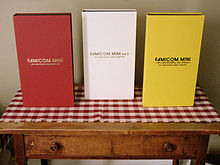 Those who bought all the games in one series could order a special collection box from Club Nintendo.
Those who bought all the games in one series could order a special collection box from Club Nintendo.
Famicom Mini
The Famicom Mini Series was released in Japan.
Series 1
Released on February 14, 2004:
- Super Mario Bros.
- Donkey Kong
- Ice Climber
- Excitebike
- Zelda no Densetsu 1 (The Legend of Zelda)
- Pac-Man
- Xevious
- Mappy
- Bomberman
- Star Soldier
Series 2
Released May 21, 2004:
- Mario Bros.
- Clu Clu Land
- Balloon Fight
- Wrecking Crew
- Dr. Mario
- Dig Dug
- Takahashi Meijin no Bōkenjima (Adventure Island)
- Makaimura (Ghosts 'n Goblins)
- TwinBee (video game)
- Ganbare Goemon! Karakuri Douchuu
Series 3
Released on August 10, 2004:
- Super Mario Bros. 2 (Super Mario Bros.: the Lost Levels)
- Nazo no Murasame Jō
- Metroid
- Palthena no Kagami (Kid Icarus)
- Link no Bōken (Zelda II: The Adventure of Link)
- Shin Oni Ga Shima
- Famicom Tantei Club: Kieta Kōkeisha
- Famicom Tantei Club Part II: Ushiro ni Tatsu Shōjo
- Akumajō Dracula (Castlevania)
- Gachapon Senshi Scramble Wars (SD Gundam Wars: Gachapon Senshi Scramble Wars)
In addition, Super Robot Taisen 2 was released as a promotional item alongside Super Robot Taisen GC.
International release
The Famicom Mini Series was retitled to Classic NES Series in North America and NES Classics in Europe.
Series 1
Series 1 was released in North America on June 7, 2004 and in Europe on July 9, 2004
Box art for Europe was numbered as follows:- 1. Super Mario Bros.
- 2. Donkey Kong
- 3. Ice Climber
- 4. Excitebike
- 5. The Legend of Zelda
- 6. Pac-Man
- 7. Xevious
- 8. Bomberman
Series 2
Series 2 was released in North America on October 25, 2004 and in Europe on January 7, 2005
- Castlevania
- Dr. Mario
- Metroid
- Zelda II: The Adventure of Link
Box art for Europe was numbered as follows:- 9. Metroid
- 10. Zelda II: The Adventure of Link
- 11. Dr. Mario
- 12. Castlevania
Comparison between the regions
- The Classic NES Series consists of 12 games, while the Famicom Mini Series consists of 30 games.
- Some highly popular games were left off the Classic NES Series. Some of these were released on the GBA in remade form, such as Tetris (as Tetris Worlds), Super Mario Bros. 2 (as Super Mario Advance), Super Mario Bros. 3 (as Super Mario Advance 4: Super Mario Bros. 3), and Kirby's Adventure (as Kirby: Nightmare in Dream Land).
- The Japanese release of Ice Climber features the seal Topis while the international copy reflects its remade characters including the yeti Topis.
- Mario Bros. was left off the Classic NES Series as a remake was already provided with each Super Mario Advance series game.
Reception
- Bomberman: Jeff Gerstmann complained that a Bomberman without multiplayer is "hardly a Bomberman at all." [1]
- Metroid: Seen as redundant, since it was already included as an unlockable extra in the remake Metroid: Zero Mission as well as in Metroid Prime.[2]
- Pac-Man: Previously released on Pac-Man Collection, which included Pac-Mania, Pac-Attack, and Pac-Man Arrangement. It was also released on the Namco Museum 50th Anniversary Edition, although the latter collections featured the arcade version rather than the NES version which was modified to fit a typical television screen.[citation needed]
- Excitebike, Donkey Kong, and Ice Climber have been previously released on the e-Reader at a fraction of the cartridge cost.
Some reviewers were annoyed that the Classic NES Series versions featured differences from the original. For example, Craig Harris complained that Xevious had an automatic firing setting, which destroyed the difficulty of the original.[3] Reviewers also complained about the lack of the pie/cement level in Donkey Kong (the pie level was in the arcade version, not the NES version, although reviewers still criticized it).[4][5] In Super Mario Bros., the screen ratio aspect was altered, causing odd graphical appearances.[6][7]
The prices of the Classic NES Series and previous rereleases were also criticized. Many reviewers noted that $20 was a high price for one game.[8][5] Both GameSpot and IGN noted that Nintendo had given away The Legend of Zelda and Zelda II: The Adventure of Link for free in the Collector's Edition bonus disc, although they conceded that the Classic NES Series version was portable.[9][10] However, reviewers consistently hailed The Legend of Zelda as one of the games worth the cost of the cartridge.[9][10][11][12]
References
- ^ Gerstmann, Jeff. GameSpot: Bomberman review. June 8, 2004
- ^ Colayco, Bob. GameSpot: Metroid review. November 3, 2004
- ^ Harris, Craig. IGN: Xevious (Classic NES Series) Review. June 4, 2004.
- ^ Gerstmann, Jeff. "Classic NES Series: Donkey Kong for the Game Boy Advance review. June 4, 2004.
- ^ a b Dr. Chapstick. "Review: Classic NES Series: Donkey Kong for Game Boy Advance. Gamepro.com. June 4, 2004.
- ^ Gerstmann, Jeff. GameSpot: Super Mario Bros. review. GameSpot. June 8, 2004
- ^ Harris, Craig. "Super Mario Bros." review. IGN. June 4, 2004.
- ^ Harris, Craig. IGN: Donkey Kong (Classic NES Series) Review". IGN. June 4, 2004.
- ^ a b Gerstmann, Jeff. "Classic NES Series: The Legend of Zelda for Game Boy Advance Review". GameSpot. June 8, 2004.
- ^ a b Harris, Craig. "IGN: The Legend of Zelda (Classic NES Series) Review. IGN. June 4, 2004.
- ^ "The Legend of Zelda (NES Classic)". 1Up.com. Retrieved February 4, 2007.
- ^ Scalzo, John "Gaming Target: Game Boy Advance: The Legend of Zelda GBA Review". Gaming Target. June 15, 2004.
External links
Categories:- Game Boy Advance games
Wikimedia Foundation. 2010.

